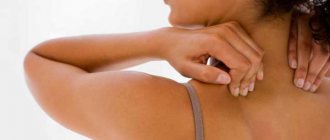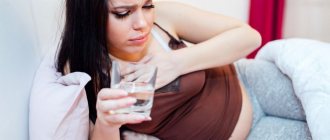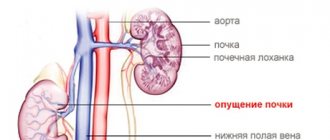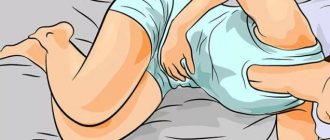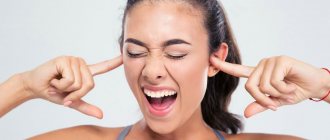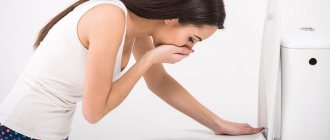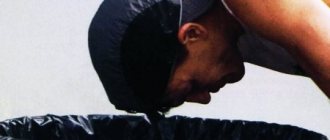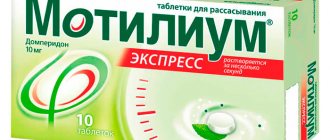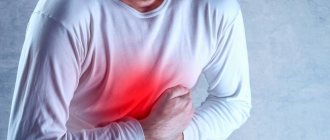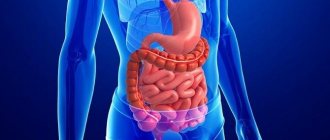Reasons for the appearance of symptoms
From the thoracic and lumbar spine stretches a network of nerve endings connected to the internal organs. When the functioning of the latter is disrupted, the autonomic system reacts to the failure and sends a signal to the spinal cord. From there the impulses go to the head center. This process may be accompanied by a persistent feeling of nausea and loss of appetite. The list of reasons includes:
- pathologies of the gastrointestinal tract;
- inflammatory processes of the urinary system;
- diseases of the genital organs;
- pregnancy;
- umbilical and inguinal hernia;
- benign neoplasms and cancerous tumors;
- spinal column injuries;
- pinching of the nerve endings of the lumbar vertebrae - lumbodynia;
- neuralgia of the sciatic nerve - sciatica.
Nausea is a protective reaction of the body. The patient does not eat, and internal reserves are aimed not at digesting food, but at improving the health of the diseased organ.
As nausea increases, repeated urges to vomit appear - this is a common occurrence with toxicosis. Diseases of the abdominal cavity are additionally accompanied by nagging, dull or sharp, cutting pain at the location of the diseased organ.
With gynecological diseases, a burning sensation in the external genital area, itching, aching pain and a feeling of heaviness in the suprapubic area appear. Severe injuries of the spinal column - fractures, displacements - are accompanied by painful shock, which can lead to loss of consciousness. With renal colic, sharp, piercing pain is localized in the right or left side of the back. They can radiate to the side, groin, or leg. After an attack, blood or sand is found in the urine.
With lumbodynia, acute pain is felt in the lumbar vertebrae. Sciatica causes numbness in the legs, goosebumps, limited mobility of the feet, and impaired reflex sensitivity. Irradiation of pain occurs to the buttocks, along the back of the thigh, to the lower leg. With an umbilical and inguinal hernia, sharp pain is felt at the site of soft tissue spilling into the hernial sac - exacerbation of the pathology leads to pre-syncope and inability to move.
Sexually transmitted diseases that affect the genital organs, and in advanced conditions, the entire body, are accompanied by white, purulent yellow-greenish discharge. Chlamydia can lurk in the body and cause relapses of the disease, despite positive test results. Gonorrhea begins with an exacerbation - the pain intensifies when urinating. Urological diseases are accompanied by frequent urge to go to the toilet and pain in the lower abdomen.
Pain in the back and pelvis, accompanied by nausea
Such symptoms indicate inflammatory processes in the pelvic area. It is recommended to monitor pregnant women especially carefully; the described clinic may indicate pathologies during pregnancy. In men, discomfort in the pelvic area indicates problems with the prostate.
If the pain is accompanied by fever, vomiting, and unusual discharge, then this indicates the seriousness of the pathological processes and requires immediate attention to medical institutions. Cystitis, ovarian cysts, gonorrhea, prostatitis, mycoplasmosis and other diseases of the pelvic organs have the same secondary symptoms.
In most cases, cystitis affects women, the reason is the anatomical features of the structure of the urinary system
The list of spinal problems that cause pain along with nausea is not very wide, but all of them can have very negative consequences and require qualified and timely treatment.
What diseases cause symptoms?
Symptoms may be caused by:
- diseases of the urinary system - urethritis, cystitis, prostatitis;
- sexually transmitted diseases – gonorrhea, chlamydia, trichomoniasis;
- fungal sexual infection - candidiasis;
- kidney diseases – pyelonephritis, urolithiasis, renal failure;
- liver diseases – hepatosis, hepatitis, cirrhosis, fibrosis;
- appendicitis - inflammation of the appendix of the rectum;
- intestinal diseases - colitis, duodenal ulcer, dysbacteriosis;
- gastric pathologies – gastritis, ulcers;
- pancreatic disease - pancreatitis;
- gynecological diseases in women - colpitis, uterine fibroids, adnexitis, endometriosis;
- cysts and malignant formations of the genital organs and abdominal cavity.
In diseases of the musculoskeletal system: scoliosis, vertebral protrusions, lumbar radiculitis, osteoporosis, scoliosis, severe back pain occurs, innervation of which can occur in the internal organs, arms and legs. But nausea rarely occurs.
How to get rid of nausea
Patients who promptly contacted a neurologist or osteopath at the first signs of the disease often ask whether they can feel sick with osteochondrosis. For a more accurate diagnosis, experts recommend diagnosing the vessels of the head and neck and taking the necessary tests. Pathologies identified at an early stage of the disease are much more effectively cured and do not entail dangerous complications.
Treatment of osteochondrosis involves complex therapy
Narrowly targeted elimination of nausea with cervical osteochondrosis does not make sense. After accurately determining the area of osteochondrosis formation, a course of treatment is prescribed individually. Under the supervision of an experienced doctor, complex therapy is carried out using physiotherapy, medications, massage, reflexology and effective methods of traditional medicine.
In cases where an attack of nausea occurs suddenly, it is advisable to use massage and exercises (physical therapy), which help restore blood circulation and improve microcirculation of brain vessels. Local massage also reduces pain and relieves swelling in the cervical region.
To eliminate disturbances of the vestibular apparatus, the following several exercises are recommended for patients who feel sick due to osteochondrosis of the cervical spine:
- The exercise is performed sitting or standing. Place the palm of your right hand on your forehead and press for 10 seconds. Repeat 5-6 times per session;
- Press your right palm to your right cheek and press (10 seconds), taking short breaks, 5-7 times in total;
- Sit on a chair, cross your arms and then, while inhaling, bend your whole body to the side; while exhaling, return to the starting position.
When an ambulance is needed
Lower back pain and nausea are observed in chronic forms, exacerbations and relapses of diseases. During an attack, symptoms increase from several minutes to several hours, reaching a peak at which the patient can no longer cope with them on his own. The condition threatens not only health, but also life. In addition to persistent nausea and back pain, weakness, cold sweat, and confusion may occur.
If the cause is an acute infectious process, then the body temperature rises to critical values - 38-40 degrees. There is a strong fever and dizziness. Nausea intensifies, the patient cannot remain in an upright position. This condition requires immediate medical attention.
Until the ambulance arrives, the patient is laid on a horizontal surface in a ventilated room, the collar of his clothes is unbuttoned, and a towel soaked in water is applied to open areas of the body. You can give an antipyretic medicine with an analgesic effect: Nurofen, Paracetamol, Novigan.
Prevention
The results of studies by medical teams from different countries indicate that the prerequisites for the development of osteochondrosis are:
- Passive lifestyle;
- Incorrect posture;
- Constant stress;
- Overweight;
- Alcohol abuse and smoking;
- Excessive physical activity;
- Unfavorable environmental conditions;
- Infections and hypothermia.
Cervical osteochondrosis affects mainly men and women aged 30-50 years. Most of them note that they feel sick with osteochondrosis, mostly before the start of a working day, when the body has not yet woken up enough, as well as during periods of prolonged sitting at the workplace.
To prevent nausea, in addition to physical therapy, doctors recommend maintaining a healthy diet. It is advisable for people prone to attacks of nausea to reduce their daily salt intake, avoid products containing caffeine, and not take medications containing aspirin.
The following 8 tips will be useful for both healthy people and patients with osteochondrosis. It is important to take into account that even at an early stage of osteochondrosis, you should not lift weights exceeding 10 kg.
8 rules for the prevention of osteochondrosis:
- Before physical activity, drink water - discs in a dehydrated body do not absorb the required amount of moisture;
- Massage your back, thereby speeding up metabolic processes;
- When lifting weights, use a cart, wheeled suitcase, or backpack;
- Do not lift objects with outstretched arms - the load on the spine will increase tenfold. Squat down and rise with the object in your hands, spine straight;
- After exertion, you need to hang (wall bars, horizontal bar, tree, etc.) or stretch with your arms raised;
- When bending over, do not make sudden movements or turns of your body;
- Distribute the load evenly. When carrying the bag in front of you, keep it close to your body;
- When cleaning the apartment, you are less bent over.
Good afternoon Please help me with advice! About two days ago, my lower back began to hurt, and this pain radiates to my legs, and all this is accompanied by nausea and dizziness (especially in the subway). Tell me, what could it be! Thank you in advance.
Anna, Russia, Moscow, 21 years old
Diagnostics
To find out the cause of nausea and back pain, you need to consult a general practitioner. A general practitioner will prescribe a set of diagnostic measures:
- blood and urine tests;
- Ultrasound of internal organs;
- microscopy of smears - to identify pathogenic pathogens of diseases of the genitourinary system;
- MRI, CT, radiography – if musculoskeletal diseases are suspected;
- gastroscopy – endoscopic examination of the stomach and intestines;
- analysis for the presence of oncogenic strains in the body.
Differential diagnosis narrows the list of possible causes - based on its results, the main “provocateur” of nausea and back pain is identified. After studying the data, the therapist refers the patient to a specialist who will prescribe treatment based on the medical history and laboratory test results.
If you experience nausea and back pain, you should immediately go to the hospital, as the symptoms may indicate a serious pathology of the internal organs. Comprehensive differential diagnosis identifies the main causes of the disease and excludes possible ones. Based on the results, a specialist will be able to choose the right direction of treatment.
Correct treatment approach and methods
Prescribing adequate therapy for pain in the lumbar region is the prerogative of the doctor.
After establishing the cause, treatment is carried out by a specialized specialist: a neurologist for osteochondrosis, a gynecologist for inflammatory diseases of the reproductive system, a gastroenterologist for gastrointestinal pathology.
Treatment is determined by the underlying cause of the pain. In the vast majority of cases of osteochondrosis, outpatient treatment using analgesics (in the form of ointments, injections or oral forms) and physiotherapeutic procedures is sufficient.
In case of surgical pathology (cholecystitis, appendicitis, pancreatitis) or large intervertebral hernias, surgical treatment comes to the fore. In the case of infectious diseases, the etiotropic use of antibacterial drugs (penicillins, cephalosporins, etc.) is etiotropic.
In case of a chronic disease with frequent exacerbations, the patient may be prescribed standard therapy for self-treatment . However, persistent pain syndrome or its debut appearance is a reason to consult a doctor.
Pathology of the genitourinary system
Most often, nausea and lower back pain occur due to urolithiasis. Even at the stage of remission, people almost always feel their back aching.
- pain in the groin, back, and genital area intensifies as the stone passes;
- burning during urination;
- symptom of congestion - when the stream is interrupted, urine flow continues when changing position;
- temperature rises;
- blood pressure rises high.
Treatment depends on the size of the stones. Small stones are eliminated with medications that increase urination or by crushing them. A surgical method is used to remove large stones.
If a man feels nauseous and his lower back hurts, most likely he has prostatitis. The first signs of inflammation of the prostate gland are mild and are not taken seriously. Over time, other symptoms appear:
- difficult and painful urination;
- severe pain radiates to the lower abdomen, anus, testicles, scrotum, perineum, back, suprapubic region;
- burning in the urethra;
- increased sweating;
- dizziness;
- a man notices accelerated ejaculation during sexual intercourse, decreased potency;
- urination becomes more frequent at night;
- sweating and chills.
Infectious prostatitis in young people develops after suffering from trichomoniasis or gonorrhea. In older age, the cause of the disease is stagnation of sperm and secretions, caused by a change in the rhythm of sexual life, rare ejaculation, and a sedentary lifestyle.
Complex therapy includes the antibiotic Rovamycin and the antibacterial drug Prostamol Uno. Reflexology, massage, ultrasound and laser treatments are used.
Pain typical for women
Due to the special physiology in women, abdominal discomfort occurs more often than men. Let's look at the reasons specific to women.
Menstruation
During puberty, from the first day of menstruation, the girl begins to be bothered by:
- nausea;
- bloating;
- bowel dysfunction;
- pulling in the lower abdomen;
- my head is spinning.
The condition lasts for several days. To ease a girl's menstruation, it is enough to take an antispasmodic.
Pregnancy
If a girl feels sick in the morning, this may be the first sign of toxicosis. During early pregnancy, you often experience a feeling of fullness, nagging pain, dizziness, and headache. Body temperature rises to 37 degrees, freezes, boils in the stomach, vomits. In the later stages of pregnancy, a woman may experience discomfort in the navel due to weakness of the abdominal muscles, and lower back pain.
Diseases of the female reproductive system
Sometimes, after menstruation, severe painful cramps do not stop - an alarming signal. Pregnancy is ruled out. If the test is negative, there are signs of diseases of the genital and urinary organs. There are cutting, burning, cramping pains.

